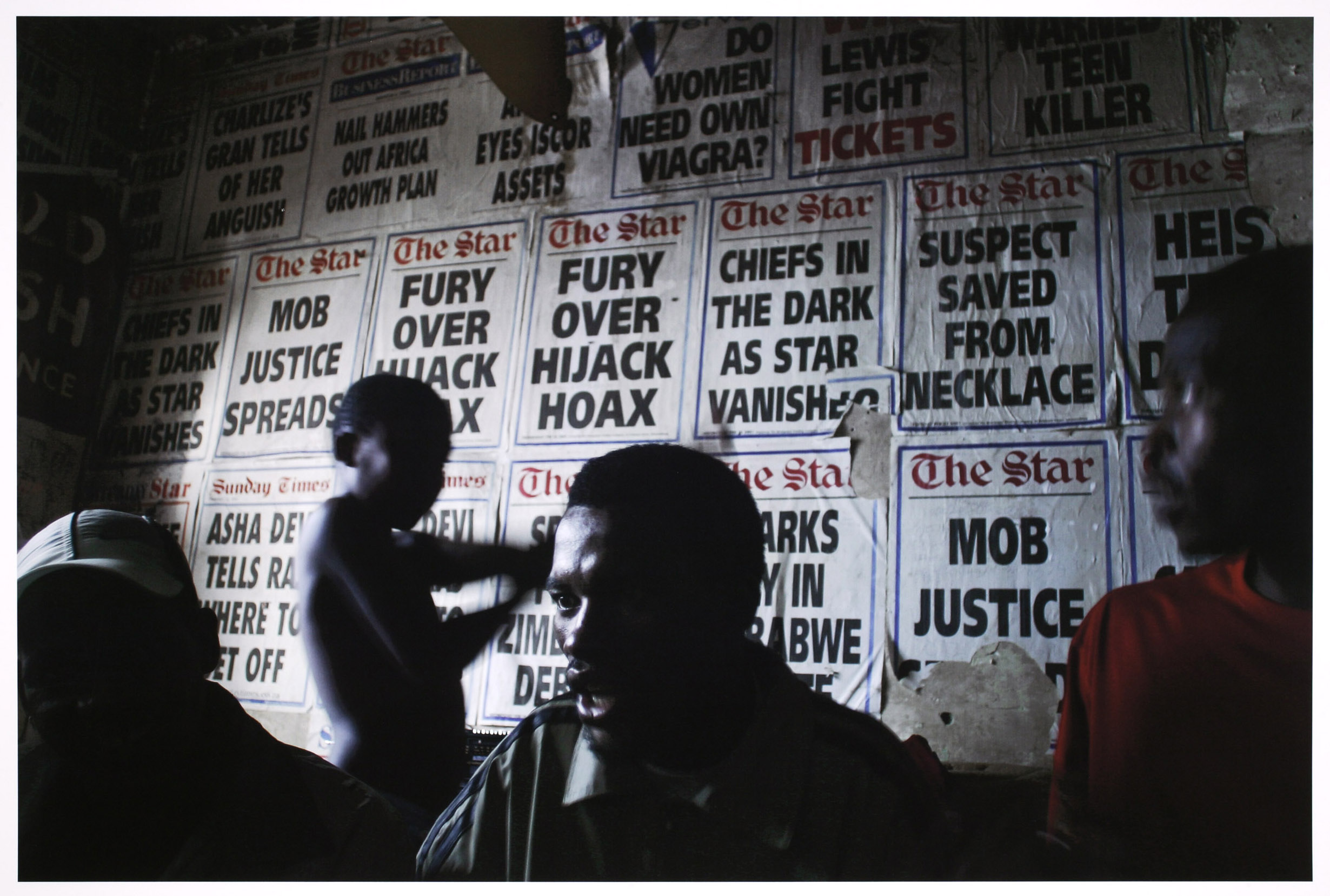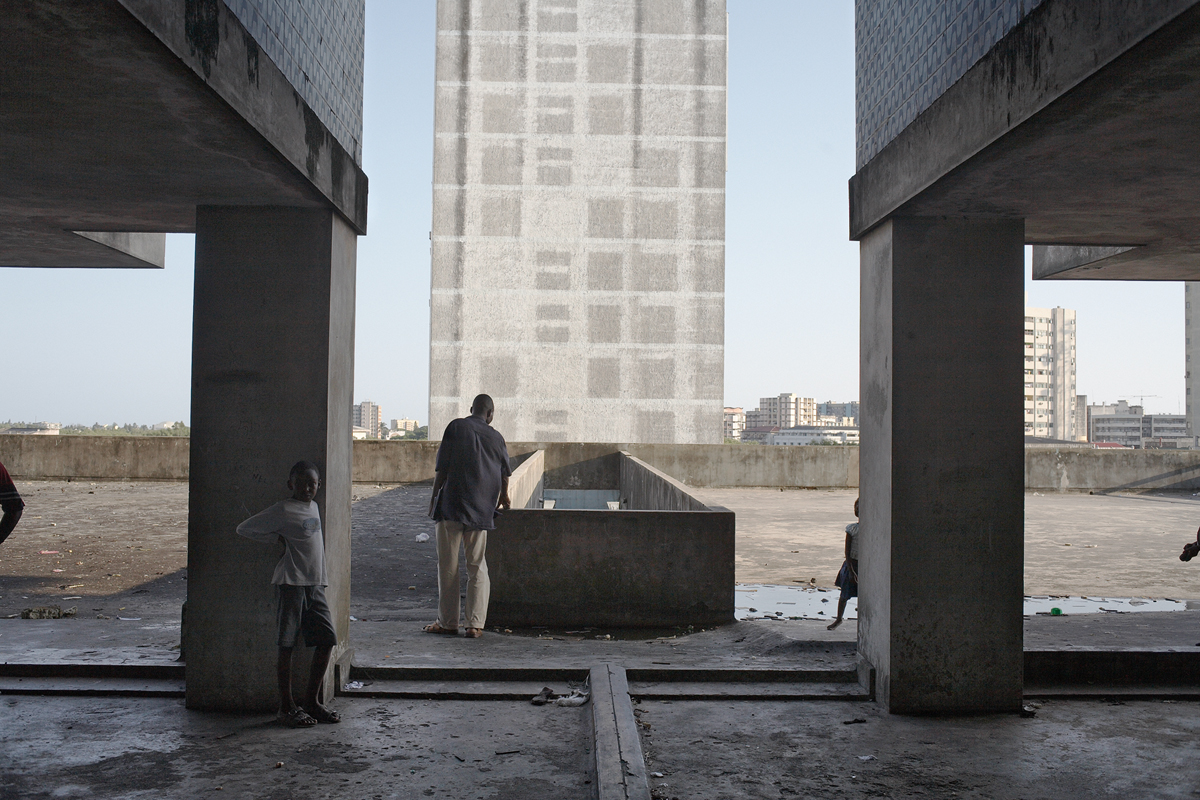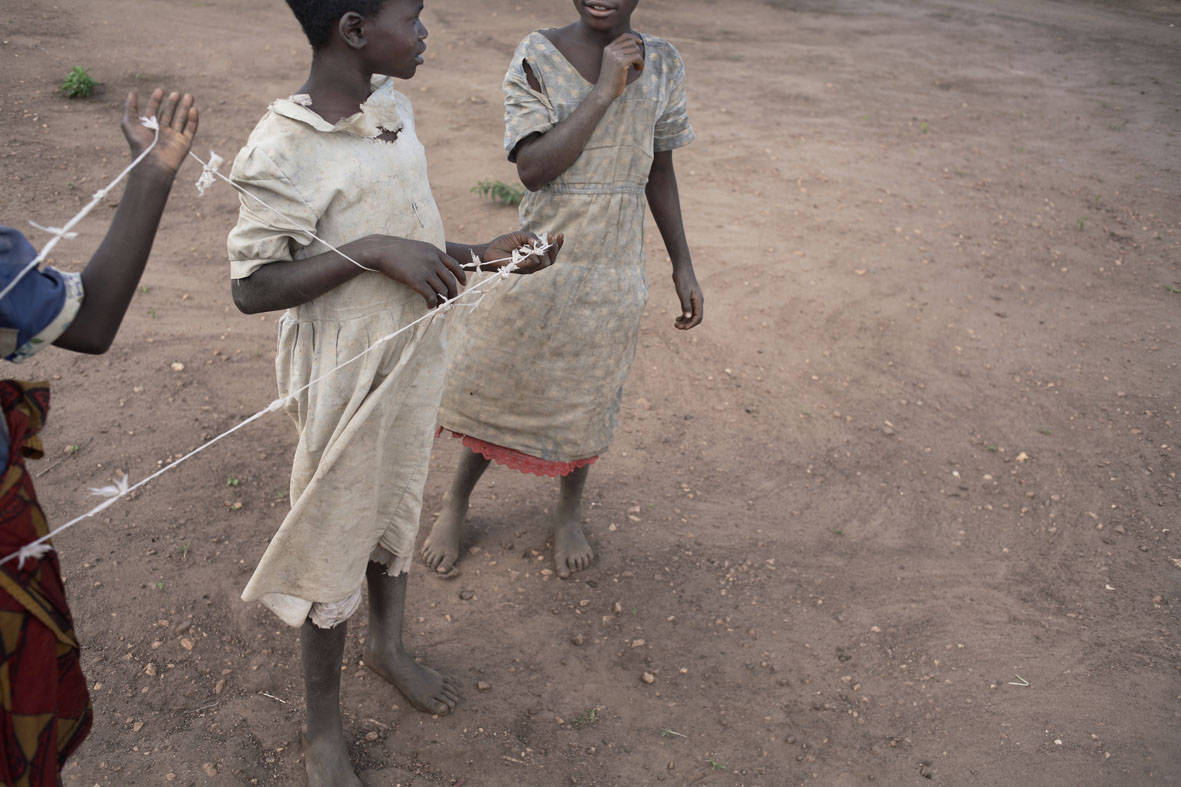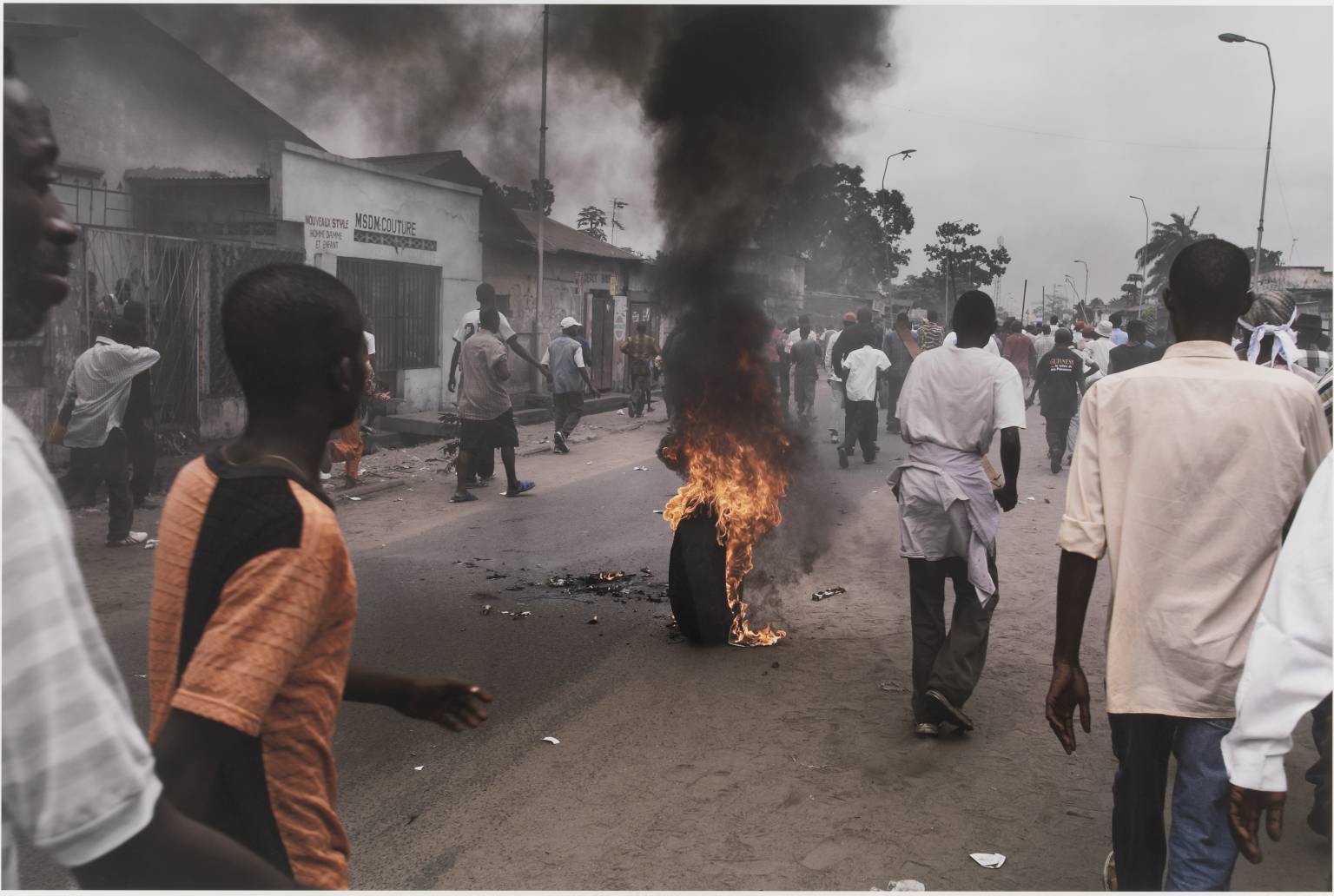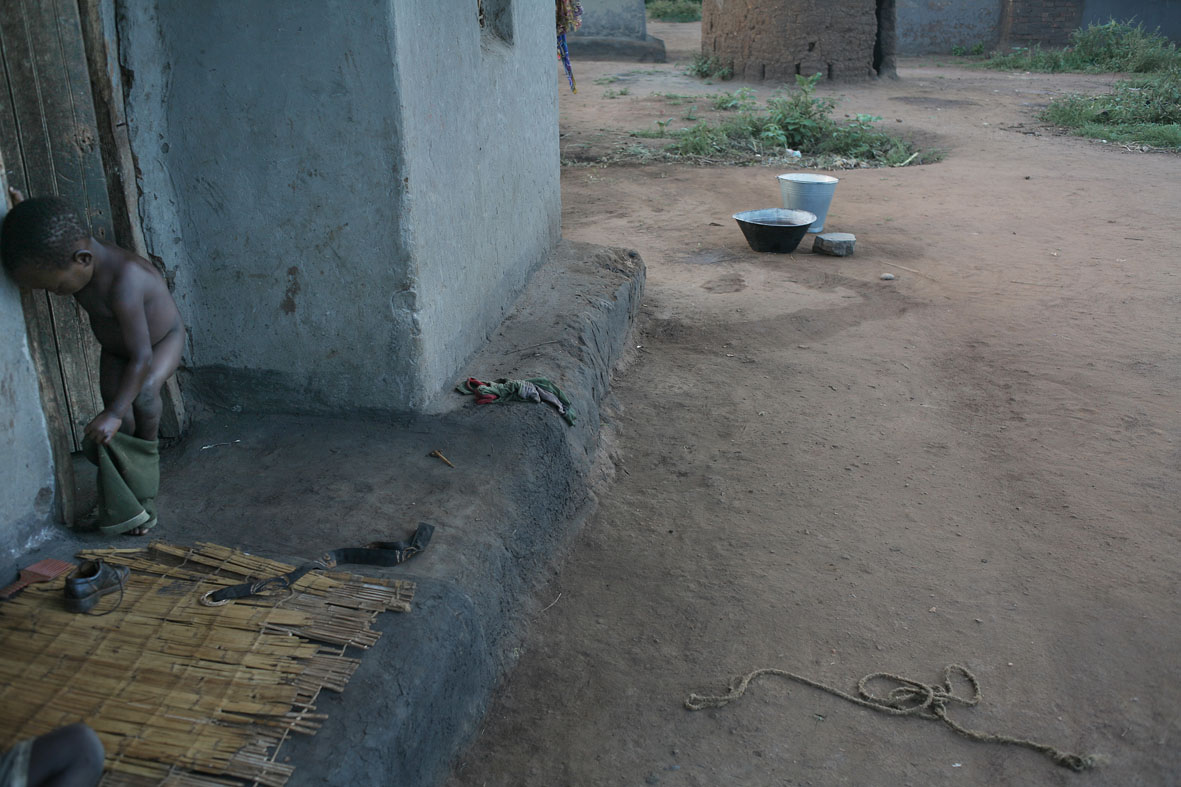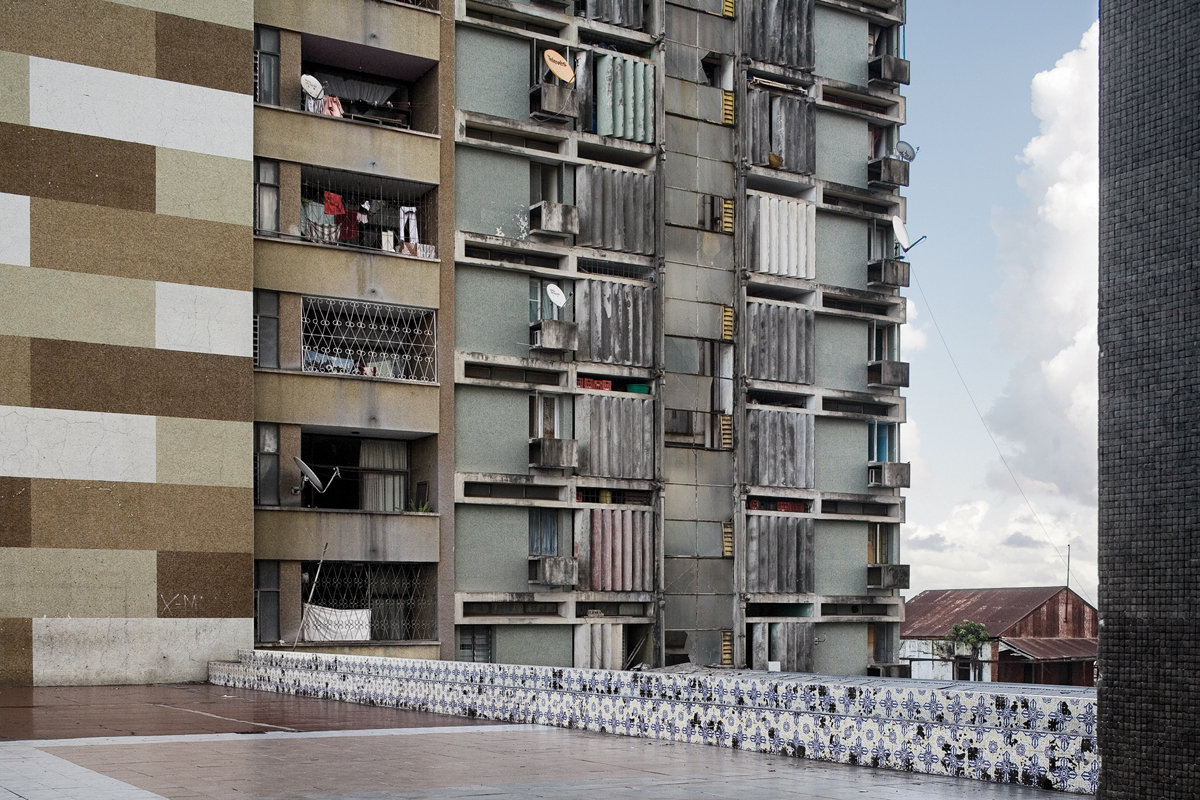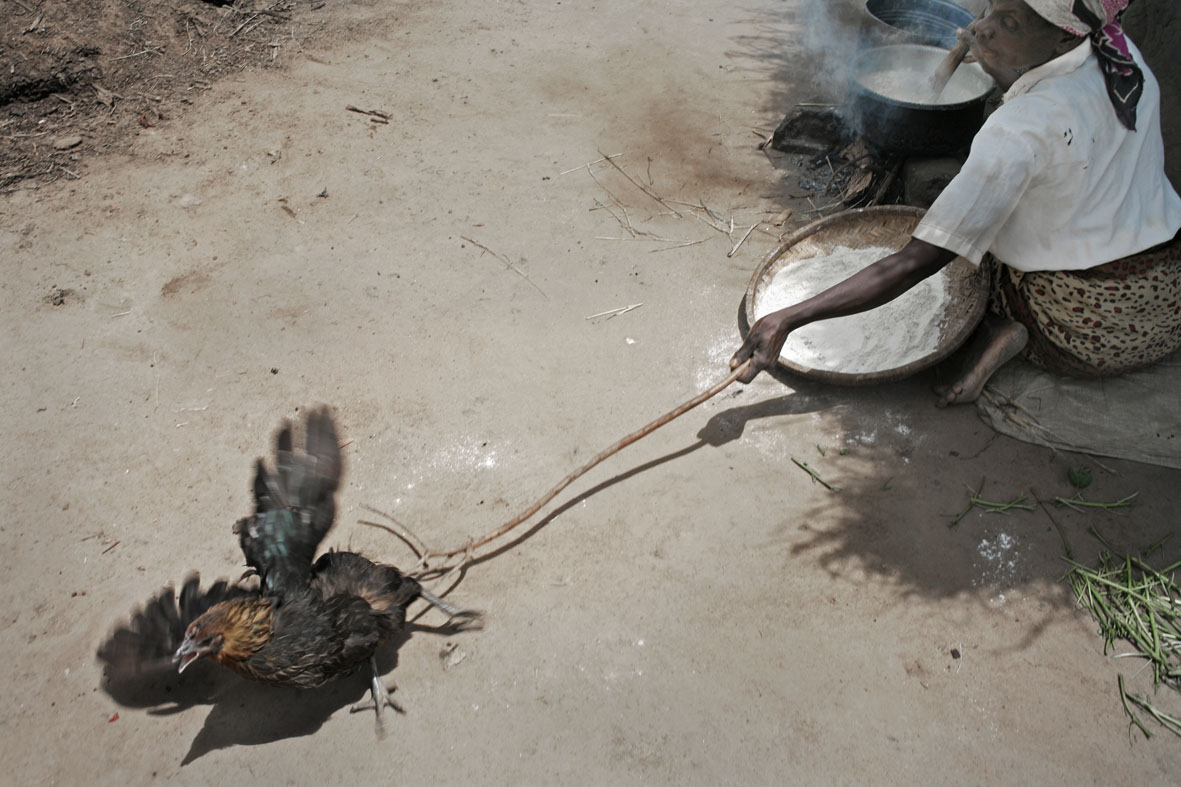Ntokozo (right) and his brother Vusi Tshabalala at Ntokozo’s place, Milton Court, Pritchard Street, from the “Jo’Burg” series, 2004
“This is obviously not a war in the conventional sense, but in the sense of a war between the have’s and have nots, undoubtedly.”
Peter Machen speaks to Guy Tillim about his Johannesburg series, Originally Published in the Natal Witness, May 2005
Guy Tillim is no ordinary war photographer. And while it would be inhuman, or at least vastly pessimistic, to even suggest that any photographs of wars can ever be called ordinary, there is nonetheless something extraordinary about the photographs that Tillim takes.
For one thing, they tend to follow in the aftermaths of wars, focussing on the physical residue and psychic ghosts that haunt the broken African landscapes of countries such as Rwanda, Eritrea and Angola. For another, they are often intensely beautiful. But it is to Tillim’s eternal credit that the content of his work is never subservient to its artistic intention or execution.
In the last few years, Tillim has been recognised by some, if not all, of the fine-art establishment as an artist, crossing the divide between media, the lone photographer and the gallery. And while there are those who object to the possibly anaesthetising context of the gallery for documentary work, Tillim is more than happy for his images to find a home in such spaces, particularly since the kind of pictures he takes seldom find their way into newspapers.
Despite his lack of commercial sensibility, Tillim has been rewarded for his work in other ways, and was last year awarded the DaimlerChrysler Award for South African Photography, for which he was required to produce a body of work. He chose to both shift and narrow his focus, and set about documenting the life of people and buildings in downtown Johannesburg. Included in the images on display in the Durban Art Gallery is a town-planning map of central Johannesburg, with different coloured drawing-pins indicating buildings in varying states of decay. Many of these buildings are marked with black pins, indicating buildings whose residents are scheduled for mass eviction. Lawyers working for these residents claim these actions are unconstitutional since the municipality is not providing alternative accommodation.
When people write about Tillim’s photographs, it is often suggested that a profound thread of hope that runs through his images. And while that sense of hope is intangibly self-evident in his many of his pictures, I’ve struggled for a while to work out from where exactly it emerges in the scarred and damaged places he documents.
And then it hit me like a cartoon lightbulb above my right shoulder. The answer is obvious, so sadly obvious. That sense of hope which lingers at the back of his images, and which shines through damaged eyes, and which appears almost religious at times, exists simply, I think, because war is over. Guy Tillim is, for the most part, a post-war photographer. So the question remains, before I launch you into our electronic conversation, as to whether Tillim’s series of photographs of inner Johannesburg also contain this element of hope. But that’s something you’ll have to decide for yourself when you check out the exhibition at the Durban Art Gallery.
PM: For this DaimlerChrysler exhibition, you have chosen to document the lives of people and buildings in inner-city Johannesburg. You are a photojournalist who has spent much of your career documenting the aftermath and residue of war. With these shots of Jozi, I’d like to suggest that you are continuing to do the same thing. Do you agree with this?
GT: This is obviously not a war in the conventional sense, but in the sense of a war between the have’s and have nots, undoubtedly. The Jo’burg images are not of the aftermath then, but the war in progress (as you suggest in your second question). Or perhaps even a prelude, though this is a dark and unfocussed thought. Maybe I am doing the same thing (as in my broader work); these are simply places that exist on the boundaries of my imaginary realm, places that affect quite profoundly the place I am from, places I feel for some reason bound to explore.
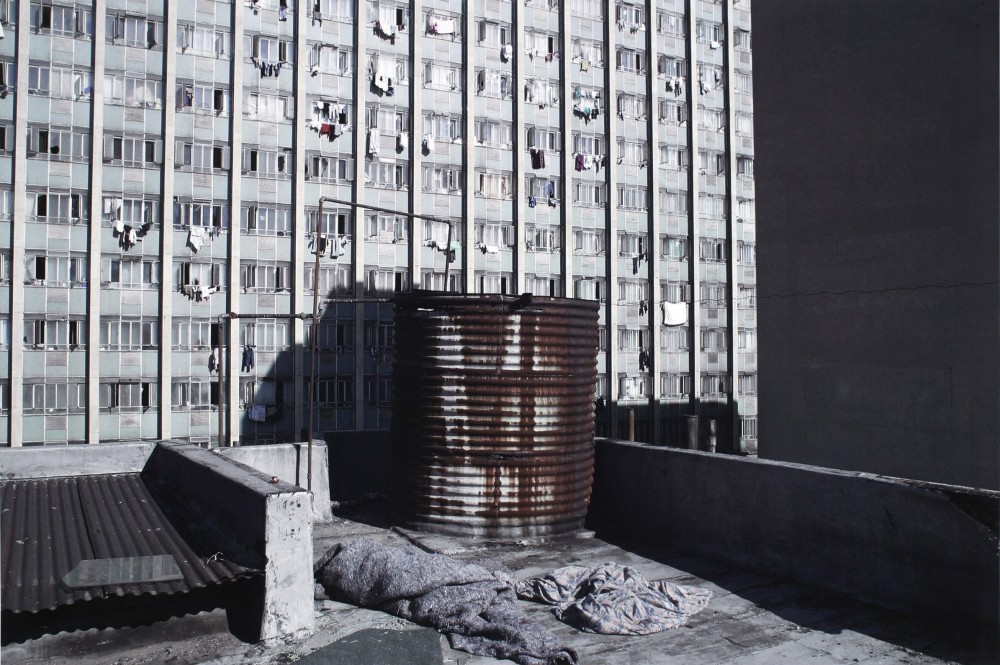
Al’s Tower, a block of flats on Harrow Road, Berea, overlooking the Ponte building, from the “Jo’Burg” series, 2004
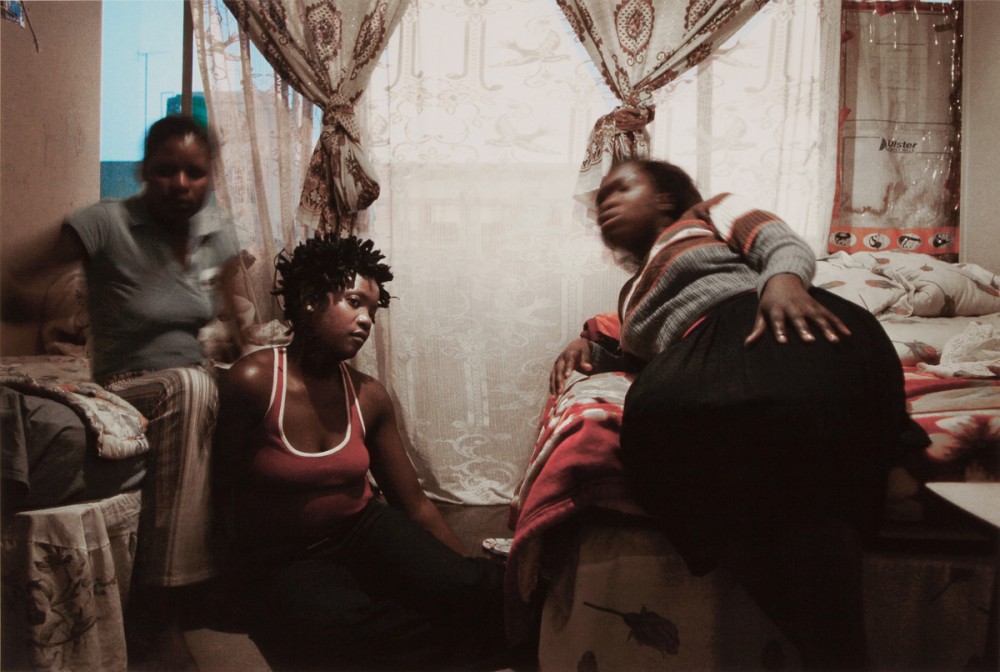
“All wars have to end. The scars emotional, physical are readily apparent. But they gradually become part of the scenery; what was foregrounded is now background. Perhaps the photographer’s means of communication best rests in accepting the background for what it is, aberrant, different, brutal, and looking for a communal human thread that links us all.”
PM: I was thinking about the difference between these images and those which catalogue the violences in the rest of Africa, and I was trying to determine for myself whether there is a fundamental difference between them. And I came upon the notion that while conventional wars always end, this war, a war between the poor and powerless and a set of power structures that they can barely identify, is a war that is never going to end. And it is a war that is echoed all over the planet in different intensities from Rio to New York, from Johannesburg to Lagos. Of course, with the recent liberation of South Africa (supposedly the liberation of working class South Africa), these images have a particular resonance. So my question is, I suppose, do you think that this war between the poor and the power structures that define their lives is one that will ever end, ever be resolved?
GT: It may not ever be resolved, but in Joburg’s case I think there are opportunities to tackle the problem in novel ways. For a start the constitutionality of evictions without provision of alternative accommodation is being challenged. There are attempts at government subsidised sectional title schemes. To some extent both the government and private developers see the possibility of a new order whereby the poor are not simply got rid of and where Joburg doesn’t revert to being a city of exclusion.
PM: And then, I’d also like to know if you think that ‘conventional’ wars do actually end in the wake of peace treaties and negotiated settlements. Or does their residue and aftermath usually continue with such substance that the war remains always rooted in the landscape and people’s faces?
GT: All wars have to end. The scars emotional, physical are readily apparent. But they gradually become part of the scenery; what was foregrounded is now background. Perhaps the photographer’s means of communication best rests in accepting the background for what it is, aberrant, different, brutal, and looking for a communal human thread that links us all.
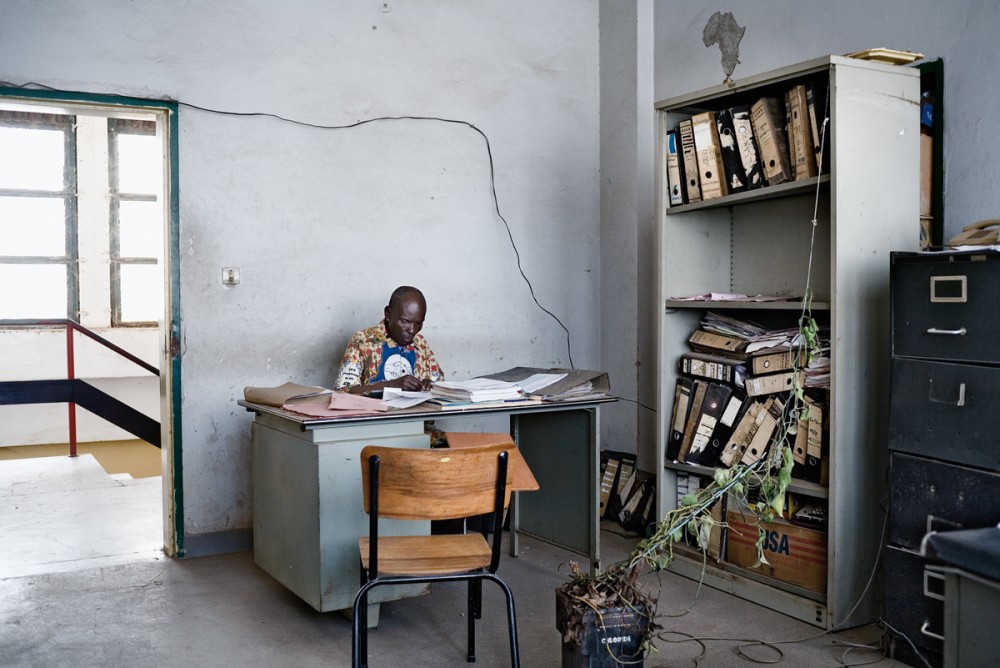
@ Guy Tillim
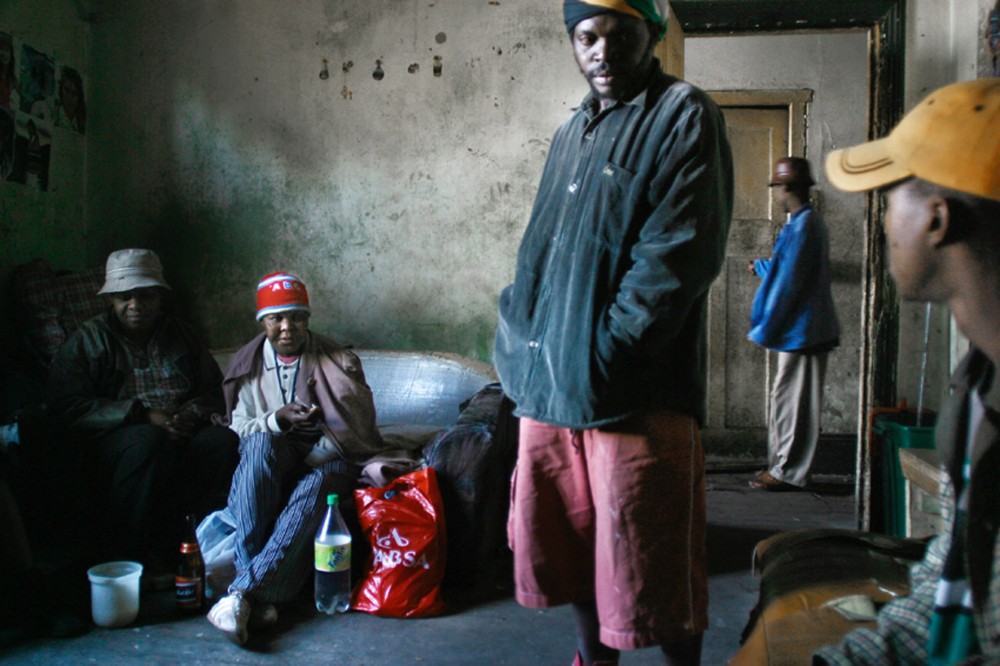
@ Guy Tillim
“I got to know a little bit most of the people photographed and so taking their names down was not difficult, and I made a point of it when it seemed natural. We’re all in the anonymous stream of history really, so it is more of an attempt to lend some dignity to a difficult and intrusive process.”
PM: The last interview that I conducted with you left a deep impression on me. I remember the photographs vividly. I even remember where many of the images were hanging in the gallery, a testament I suppose to your own curatorial powers. But I also remember sitting at the top of the stairs of the NSA gallery and talking to you. And I was struck by your sense of self, your quietness and utter lack of arrogance, and by the fact that you contained both a sense of brokenness and a sense of peace with the fractured world. You are a million miles away from the stereotype of a war photographer. Of course you began with the idealism that came with documenting and opposing the atrocities of apartheid, but I’d like to know if there was ever a turning point for you; a point which utterly changed Guy Tillim? Or perhaps, in different words, was there ever a breaking point for Guy Tillim?
GT: Turning points in my life have been more subtle changes in direction, than events that have these big consequences. More of an incremental process of narrowing options (and I have been privileged with some) in the hope of broadening one’s mind a little. The Jo’burg work is a consequence of that, an attempt to narrow the focus; it is not a portrait of Jo’burg. rather an attempt to move behind facades; walls as well as preconceptions.
PM: In the beautifully written essay ‘Departure’, you talk about the fact that you have photographs you like for reasons you have come to distrust. And the thing that makes you stand out as a photojournalist is the fact that (as Rory Bester says in the DaimlerChrysler catalogue) your aesthetic form and political (or ethical) content are at times seamless. You manage to produce exceedingly beautiful images where the content is never overshadowed by the visual treatment or composition. Is this something that comes naturally to you, or is it something that you actively try to achieve?
GT: It is something that comes naturally I suppose. At the same time, the aesthetic is gleaned from all manner or sources, converging in an approach and and then a moment. But the obscure provenance of this aesthetic (coupled with the relatively mechanical process of image production) is a cause of concern and sometimes distrust. The verisimilitude of photojournalism often exudes certainty without the subtlety of doubt and degree of introspection that is crucial in establishing an author’s bona fides.
PM: At the same time you admit to capturing the ‘worthy moment’, which also points to all the countless moments of truth which go undocumented. Are there any photographs you have taken, which beyond the notion of looking for the photographic moment, have amounted to a visual lie?
GT: Yes, but I won’t tell you which ones! Perhaps in this context there are no lies, but then there is no truth either.
PM: I was told that you used a tripod for your Jozi images. Which implies both that you were sufficiently at ease to use a tripod in a city where at least one photographer has been killed for his equipment, and also that your subjects were comfortable with being photographed by you. So I’d like to know how long you spent with your subjects before you took the pictures. Did you get to know them at all, or is this simply further evidence of the gift you have as a photographer?
GT: Time with the subjects differed. Most of the time it was a lengthy process of going through a committee in the building and then meeting individuals. Whom I would visit a few times, they’d get used to me hanging around, would often invite me to take photographs. I was working with someone who knew the city pretty well. He’d introduce me and people would decide: ja, well, fine, he seems ok, or, no. On a few occasions I was shown the door quite smartly.
PM: Finally, an element of your work that is important to me is the fact that you usually supply the actual names of your subject. This is extremely unusual in the canon of photojournalism where people are more normally reduced to mere faces, almost incidental reflections in the waters of history. Is this an important part of your work for you? Renate Wiehager talks about the fact that your striking individualisation lifts your subjects outs of the anonymous stream of history. I think its an extremely accurate statement but is it one with which you agree, and is this something you actively try to achieve?
GT: I got to know a little bit most of the people photographed and so taking their names down was not difficult, and I made a point of it when it seemed natural. We’re all in the anonymous stream of history really, so it is more of an attempt to lend some dignity to a difficult and intrusive process.
For more of American Suburb X, become a fan on Facebook and follow ASX on Twitter.
For inquiries, please contact American Suburb X at: info@americansuburbx.com.
(© Peter Machen. All rights reserved. All images © copyright the photographer and/or publisher)
